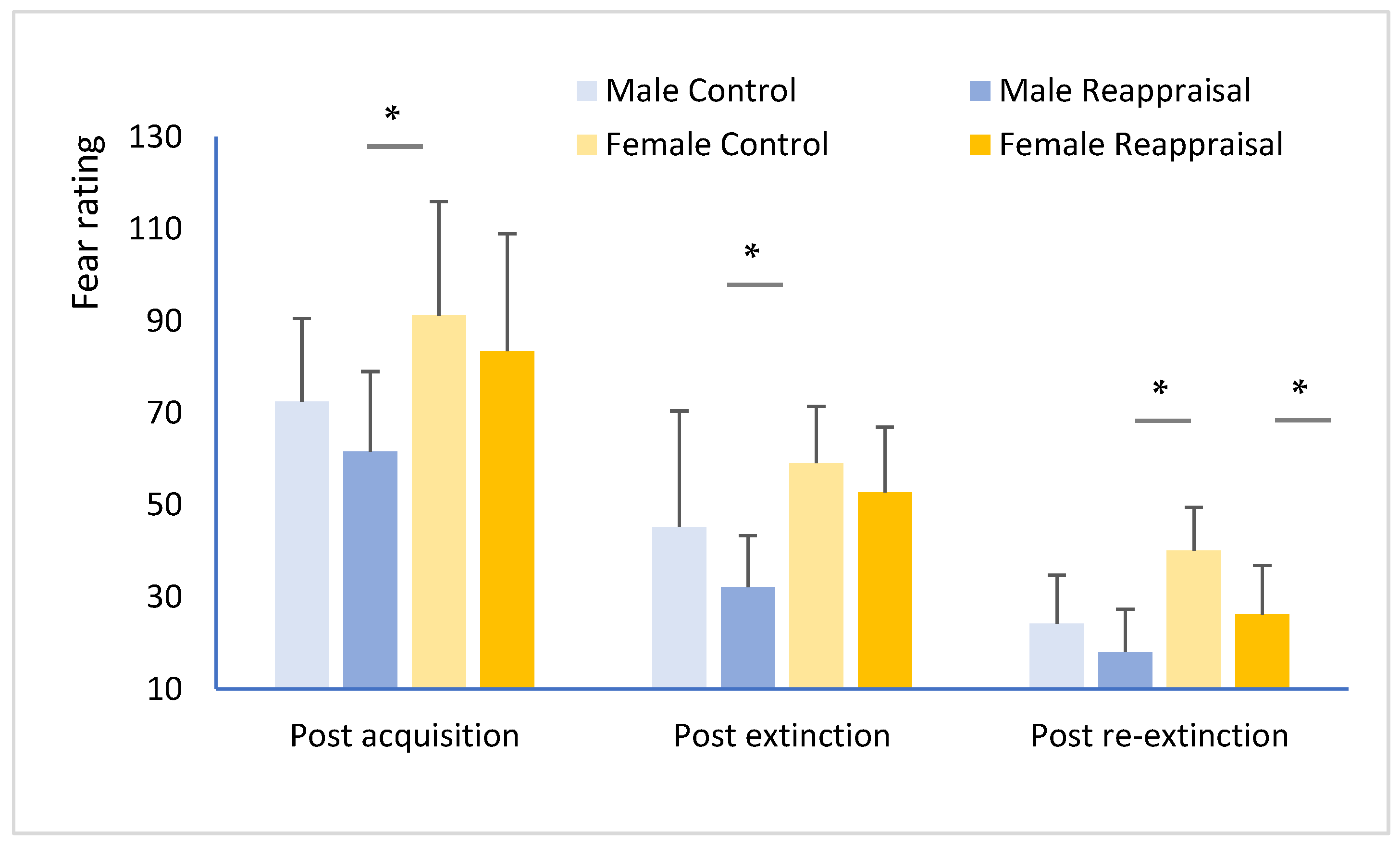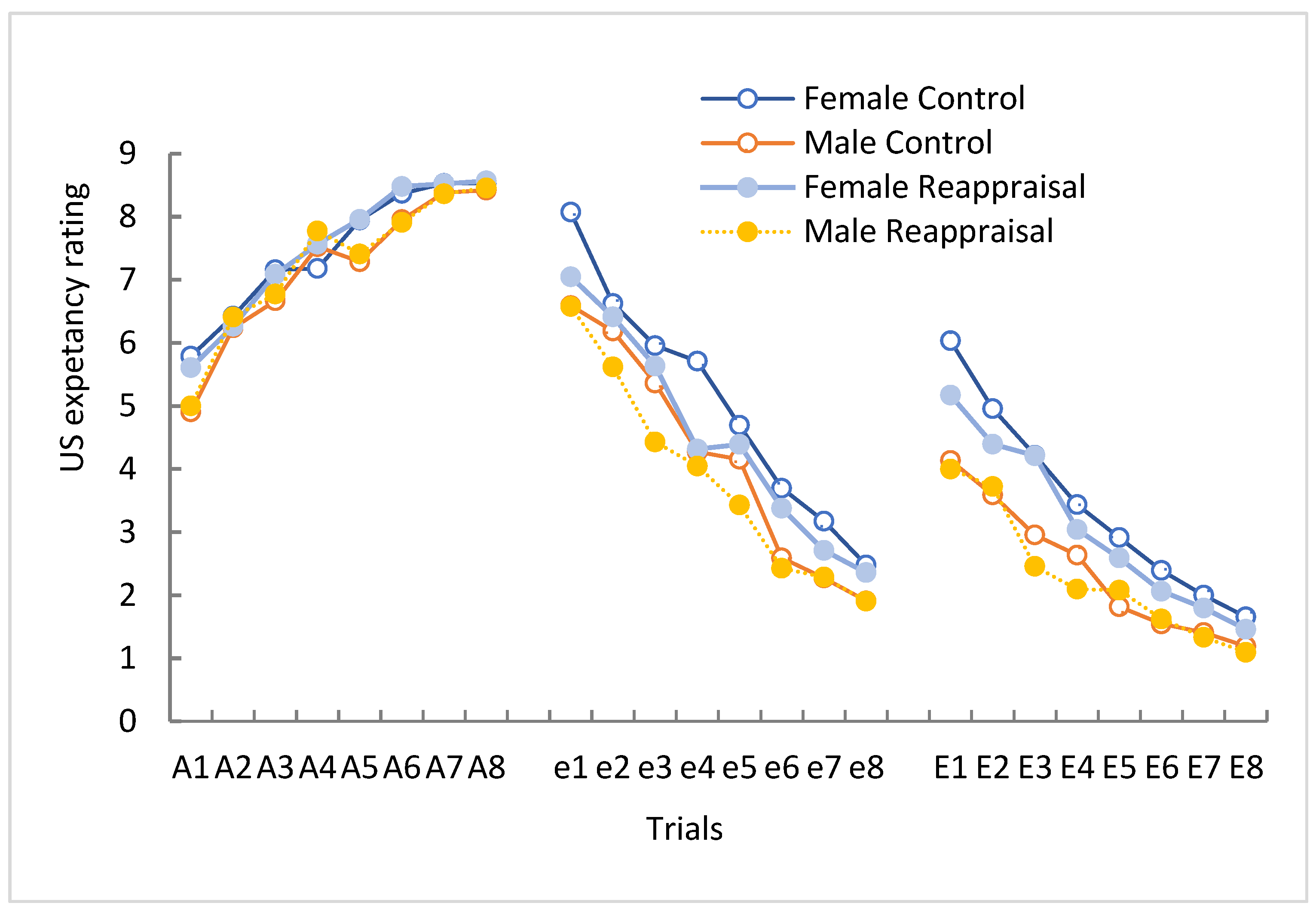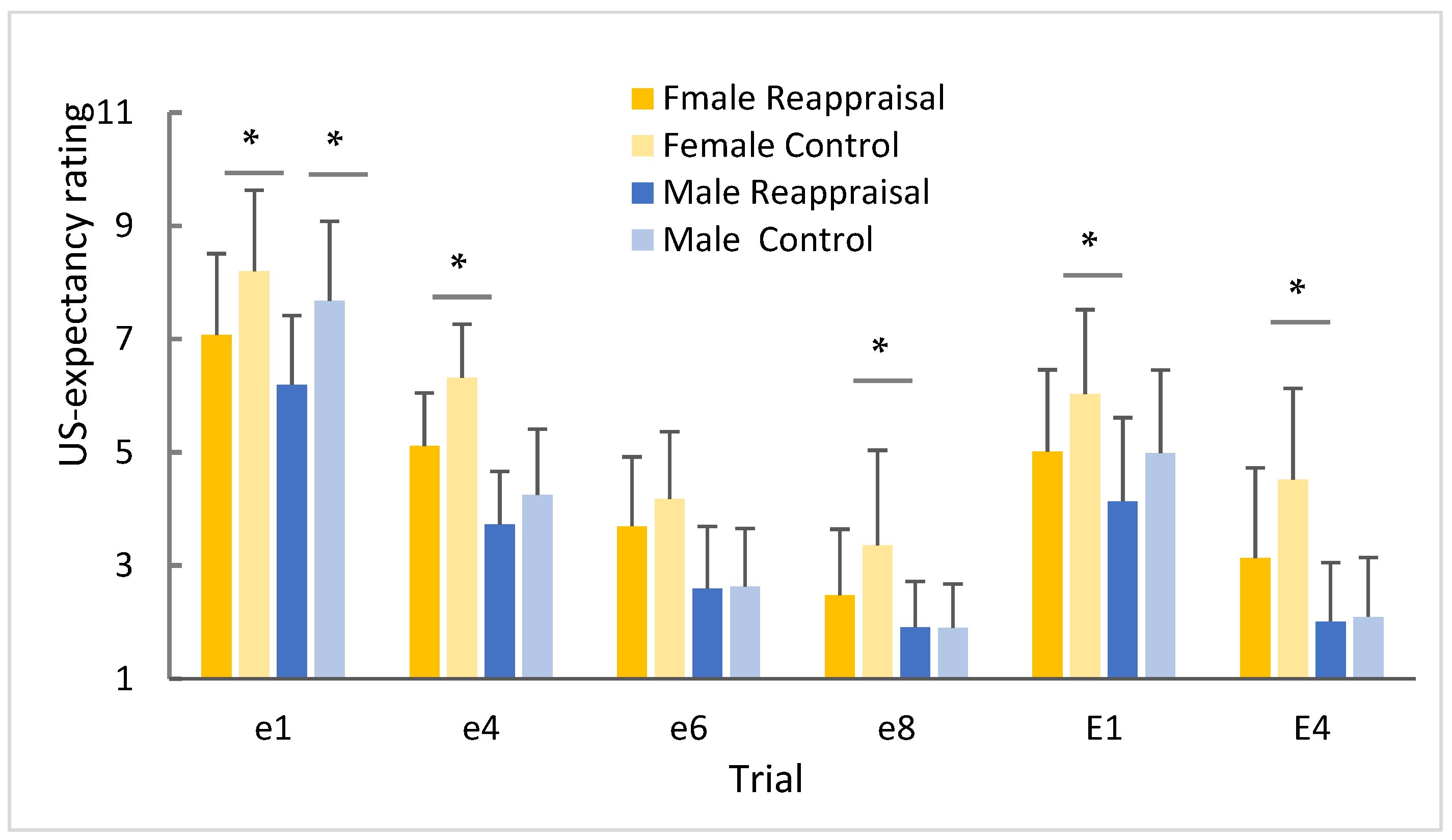Sex Differences in the Effects of Cognitive Reappraisal Training on Conditioned Fear Responses
Abstract
1. Introduction
2. Materials and Methods
2.1. Participants
2.2. Experimental Apparatus and Materials
2.2.1. Stimuli
2.2.2. US-Expectancy Measure
2.2.3. CS Fear Ratings
2.3. Positive Cognitive Reappraisal Training
2.4. Experimental Design and Procedure
2.5. Data Analysis
3. Results
3.1. Fear Rating
3.2. US Expectancy
3.2.1. Acquisition
3.2.2. Extinction
4. Discussion
4.1. Cognitive Reappraisal Significantly Reduces the Negative Valence of Acquired Fear in Females
4.2. Cognitive Reappraisal Rapidly Improves the Extinction of Conditioned Fear in Men
4.3. Cognitive Reappraisal Improving the Extinction of Conditioned Fear in Woman Needs More Practice
5. Conclusions
Author Contributions
Funding
Institutional Review Board Statement
Informed Consent Statement
Data Availability Statement
Conflicts of Interest
References
- Nolen-Hoeksema, S. Emotion regulation and psychopathology: The role of gender. Annu. Rev. Clin. Psychol. 2012, 8, 161–187. [Google Scholar] [CrossRef]
- Weiss, N.H.; Contractor, A.A.; Forkus, S.R.; Goncharenko, S.; Raudales, A.M. Positive Emotion Dysregulation Among Community Individuals: The Role of Trauma Exposure and Posttraumatic Stress Disorder. J. Trauma Stress. 2020, 33, 741–749. [Google Scholar] [CrossRef] [PubMed]
- Inslicht, S.S.; Metzler, T.J.; Garcia, N.M.; Pineles, S.L.; Milad, M.R.; Orr, S.P.; Marmar, C.R.; Neylan, T.C. Sex differences in fear conditioning in posttraumatic stress disorder. J. Psychiatr. Res. 2013, 47, 64–71. [Google Scholar] [CrossRef] [PubMed]
- Maeng, L.Y.; Milad, M.R. Sex differences in anxiety disorders: Interactions between fear, stress, and gonadal hormones. Horm. Behav. 2015, 76, 106–117. [Google Scholar] [CrossRef] [PubMed]
- Lissek, S.; Powers, A.S.; McClure, E.B.; Phelps, E.A.; Woldehawariat, G.; Grillon, C.; Pine, D.S. Classical fear conditioning in the anxiety disorders: A meta-analysis. Behav. Res. Ther. 2005, 43, 1391–1424. [Google Scholar] [CrossRef] [PubMed]
- Dark, H.E.; Harnett, N.G.; Hurst, D.R.; Wheelock, M.D.; Wood, K.H.; Goodman, A.M.; Mrug, S.; Elliott, M.N.; Emery, S.T.; Schuster, M.A.; et al. Sex-related differences in violence exposure, neural reactivity to threat, and mental health. Neuropsychopharmacology 2022, 47, 2221–2229. [Google Scholar] [CrossRef] [PubMed]
- Aldao, A.; Nolen-Hoeksema, S.; Schweizer, S. Emotion regulation strategies across psychopathology: A meta-analytic review. Clin. Psychol. Rev. 2010, 30, 217–237. [Google Scholar] [CrossRef]
- Luck, C.C.; Lipp, O.V. Relapse of evaluative learning-Evidence for reinstatement, renewal, but not spontaneous recovery, of extinguished evaluative learning in a picture-picture evaluative conditioning paradigm. J. Exp. Psychol. Learn Mem. Cogn. 2020, 46, 1178–1206. [Google Scholar] [CrossRef] [PubMed]
- Gonzalez-Escamilla, G.; Dörfel, D.; Becke, M.; Trefz, J.; Bonanno, G.A.; Groppa, S. Associating Flexible Regulation of Emotional Expression with Psychopathological Symptoms. Front. Behav. Neurosci. 2022, 16, 924305. [Google Scholar] [CrossRef]
- Hermann, A.; Bieber, A.; Keck, T.; Vaitl, D.; Stark, R. Brain structural basis of cognitive reappraisal and expressive suppression. Soc. Cogn. Affect Neurosci. 2014, 9, 1435–1442. [Google Scholar] [CrossRef]
- Gross, J.J. Emotion regulation: Affective, cognitive, and social consequences. Psychophysiology 2002, 39, 281–291. [Google Scholar] [CrossRef] [PubMed]
- Gross, J.J.; John, O.P. Individual differences in two emotion regulation processes: Implications for affect, relationships, and well-being. J. Pers. Soc. Psychol. 2003, 85, 348–362. [Google Scholar] [CrossRef] [PubMed]
- Buhle, J.T.; Silvers, J.A.; Wager, T.D.; Lopez, R.; Onyemekwu, C.; Kober, H.; Weber, J.; Ochsner, K.N. Cognitive reappraisal of emotion: A meta-analysis of human neuroimaging studies. Cereb Cortex. 2014, 24, 2981–2990. [Google Scholar] [CrossRef] [PubMed]
- Steward, T.; Davey, C.G.; Jamieson, A.J.; Stephanou, K.; Soriano-Mas, C.; Felmingham, K.L.; Harrison, B.J. Dynamic Neural Interactions Supporting the Cognitive Reappraisal of Emotion. Cereb Cortex. 2021, 31, 961–973. [Google Scholar] [CrossRef] [PubMed]
- Perlman, G.; Simmons, A.N.; Wu, J.; Hahn, K.S.; Tapert, S.F.; Max, J.E.; Paulus, M.P.; Brown, G.G.; Frank, G.K.; Campbell-Sills, L.; et al. Amygdala response and functional connectivity during emotion regulation: A study of 14 depressed adolescents. J. Affect. Disord. 2012, 139, 75–84. [Google Scholar] [CrossRef] [PubMed]
- Mohammed, A.R.; Kosonogov, V.; Lyusin, D. Expressive suppression versus cognitive reappraisal: Effects on self-report and peripheral psychophysiology. Int. J. Psychophysiol. 2021, 167, 30–37. [Google Scholar] [CrossRef] [PubMed]
- Shapero, B.G.; Stange, J.P.; McArthur, B.A.; Abramson, L.Y.; Alloy, L.B. Cognitive reappraisal attenuates the association between depressive symptoms and emotional response to stress during adolescence. Cogn. Emot. 2019, 33, 524–535. [Google Scholar] [CrossRef] [PubMed]
- Fredrikson, M.; Hugdahl, K.; Ohman, A. Electrodermal conditioning to potentially phobic stimuli in male and female subjects. Biol. Psychol. 1976, 4, 305–314. [Google Scholar] [CrossRef] [PubMed]
- Qing, Z.; Xifu, Z. Research on gender differences in the acquisition of aversion and fear: An ERP study. Psychol. Behav. Res. 2018, 16, 624–631. [Google Scholar]
- Nan, S.; Xifu, Z. Gender difference in conditional relevance learning and regression process. J. Psychol. 2014, 46, 507–515. [Google Scholar]
- Blechert, J.; Wilhelm, F.H.; Williams, H.; Braams, B.R.; Jou, J.; Gross, J.J. Reappraisal facilitates extinction in healthy and socially anxious individuals. J. Behav. Ther. Exp. Psychiatry 2015, 46, 141–150. [Google Scholar] [CrossRef] [PubMed]
- Suqun, L.; Xifu, Z. Inhibition of negative valence by cognitive reappraisal promotes the regression of conditioned fear. J. Psychol. 2016, 48, 352–361. [Google Scholar]
- Shurick, A.A.; Hamilton, J.R.; Harris, L.T.; Roy, A.K.; Gross, J.J.; Phelps, E.A. Durable effects of cognitive restructuring on conditioned fear. Emotion 2012, 12, 1393–1397. [Google Scholar] [CrossRef]
- Hermann, A.; Keck, T.; Stark, R. Dispositional cognitive reappraisal modulates the neural correlates of fear acquisition and extinction. Neurobiol. Learn. Mem. 2014, 113, 115–124. [Google Scholar] [CrossRef]
- Delgado, M.R.; Nearing, K.I.; Ledoux, J.E.; Phelps, E.A. Neural circuitry underlying the regulation of conditioned fear and its relation to extinction. Neuron 2008, 59, 829–838. [Google Scholar] [CrossRef]
- Faul, F.; Erdfelder, E.; Lang, A.G.; Buchner, A. G*power 3: A flexible statistical power analysis program for the social, behavioral, and biomedical sciences. Behav. Res. Methods 2007, 39, 175–191. [Google Scholar] [CrossRef] [PubMed]
- Iberico, C.; Vansteenwegen, D.; Vervliet, B.; Dirikx, T.; Marescau, V.; Hermans, D. The development of cued versus contextual conditioning in a predictable and an unpredictable human fear conditioning preparation. Acta Psychol. 2008, 127, 593–600. [Google Scholar] [CrossRef]
- An, X.; Chen, S. Cognitive reappraisal blocks the acquisition and expression of conditioned fear memory—long-term inhibition of fear response. J. Psychol. 2016, 48, 1239–1247. [Google Scholar]
- Clark, J.W.; Drummond, S.P.A.; Hoyer, D.; Jacobson, L.H. Sex differences in mouse models of fear inhibition: Fear extinction, safety learning, and fear-safety discrimination. Br. J. Pharmacol. 2019, 176, 4149–4158. [Google Scholar] [CrossRef] [PubMed]
- Rudolph, K.D.; Davis, M.M.; Modi, H.H.; Fowler, C.; Kim, Y.; Telzer, E.H. Differential Susceptibility to Parenting in Adolescent Girls: Moderation by Neural Sensitivity to Social Cues. J. Res. Adolesc. 2020, 30 (Suppl. 1), 177–191. [Google Scholar] [CrossRef] [PubMed]
- Chen, W.; Lin, X.; Li, J.; Zhang, W.; Sun, N.; Zheng, X. Gender differences in withdrawal and regression of conditional fear. J. Psychol. 2021, 53, 1082–1093. [Google Scholar]
- Ochsner, K.N.; Silvers, J.A.; Buhle, J.T. Functional imaging studies of emotion regulation: A synthetic review and evolving model of the cognitive control of emotion. Ann. N. Y. Acad. Sci. 2012, 1251, E1–E24. [Google Scholar] [CrossRef] [PubMed]
- Brunetti, M.; Sepede, G.; Mingoia, G.; Catani, C.; Ferretti, A.; Merla, A.; Del Gratta, C.; Romani, G.L.; Babiloni, C. Elevated response of human amygdala to neutral stimuli in mild post traumatic stress disorder: Neural correlates of generalized emotional response. Neuroscience 2010, 14, 670–679. [Google Scholar] [CrossRef]
- Putman, P.; Hermans, E.J.; Koppeschaar, H.; van Schijndel, A.; van Honk, J. A single administration of cortisol acutely reduces preconscious attention for fear in anxious young men. Psychoneuroendocrinology 2007, 32, 793–802. [Google Scholar] [CrossRef]
- Raio, C.M.; Orederu, T.A.; Palazzolo, L.; Shurick, A.A.; Phelps, E.A. Cognitive emotion regulation fails the stress test. Proc. Natl. Acad. Sci. USA 2013, 110, 15139–15144. [Google Scholar] [CrossRef] [PubMed]
- Lupien, S.J.; Leclaire, S.; Majeur, D.; Raymond, C.; Jean Baptiste, F.; Giguère, C.E. ‘Doctor, I am so stressed out!’ A descriptive study of biological, psychological, and socioemotional markers of stress in individuals who self-identify as being ‘very stressed out’ or ‘zen’. Neurobiol. Stress 2022, 18, 100454. [Google Scholar] [CrossRef] [PubMed]
- Luchkina, N.V.; Bolshakov, V.Y. Mechanisms of fear learning and extinction: Synaptic plasticity-fear memory connection. Psychopharmacology 2019, 236, 163–182. [Google Scholar] [CrossRef] [PubMed]
- McRae, K.; Ochsner, K.N.; Mauss, I.B.; Gabrieli, J.J.D.; Gross, J.J. Gender Differences in Emotion Regulation: An fMRI Study of Cognitive Reappraisal. Group Process Intergroup Relat. 2008, 11, 143–162. [Google Scholar] [CrossRef]
- Dixon, M.L.; Thiruchselvam, R.; Todd, R.; Christoff, K. Emotion and the prefrontal cortex: An integrative review. Psychol. Bull. 2017, 143, 1033–1081. [Google Scholar] [CrossRef] [PubMed]
- Amidfar, M.; Ko, Y.H.; Kim, Y.K. Neuromodulation and Cognitive Control of Emotion. Adv. Exp. Med. Biol. 2019, 1192, 545–564. [Google Scholar] [PubMed]
- Wang, X.; He, Y.; Feng, Z. The antidepressant effect of cognitive reappraisal training on individuals cognitively vulnerable to depression: Could cognitive bias be modified through the prefrontal-amygdala circuits? Front. Hum. Neurosci. 2022, 16, 919002. [Google Scholar] [CrossRef] [PubMed]



Publisher’s Note: MDPI stays neutral with regard to jurisdictional claims in published maps and institutional affiliations. |
© 2022 by the authors. Licensee MDPI, Basel, Switzerland. This article is an open access article distributed under the terms and conditions of the Creative Commons Attribution (CC BY) license (https://creativecommons.org/licenses/by/4.0/).
Share and Cite
Liao, S.; Xiao, W.; Wang, Y. Sex Differences in the Effects of Cognitive Reappraisal Training on Conditioned Fear Responses. Int. J. Environ. Res. Public Health 2022, 19, 15837. https://doi.org/10.3390/ijerph192315837
Liao S, Xiao W, Wang Y. Sex Differences in the Effects of Cognitive Reappraisal Training on Conditioned Fear Responses. International Journal of Environmental Research and Public Health. 2022; 19(23):15837. https://doi.org/10.3390/ijerph192315837
Chicago/Turabian StyleLiao, Suqun, Wen Xiao, and Yancai Wang. 2022. "Sex Differences in the Effects of Cognitive Reappraisal Training on Conditioned Fear Responses" International Journal of Environmental Research and Public Health 19, no. 23: 15837. https://doi.org/10.3390/ijerph192315837
APA StyleLiao, S., Xiao, W., & Wang, Y. (2022). Sex Differences in the Effects of Cognitive Reappraisal Training on Conditioned Fear Responses. International Journal of Environmental Research and Public Health, 19(23), 15837. https://doi.org/10.3390/ijerph192315837




